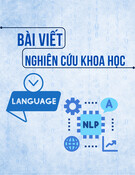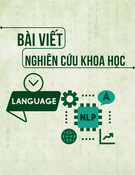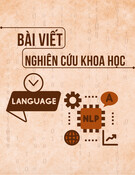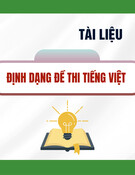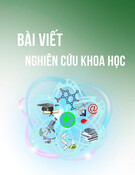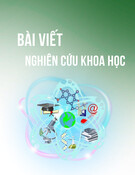
VĂN HÓA https://jst-haui.vn
Tạp chí Khoa học và Công nghệ Trường Đại học Công nghiệp Hà Nội Tập 61 - Số 2 (02/2025)
124
NGÔN NG
Ữ
P
-
ISSN 1859
-
3585
E
-
ISSN 2615
-
961
9
EXPLORING AI IN EDUCATION: STUDENT PRACTICES
AND CHALLENGES AT HANOI UNIVERSITY OF INDUSTRY
KHÁM PHÁ AI TRONG GIÁO DỤC: THỰC HÀNH VÀ THÁCH THỨC
CỦA SINH VIÊN TẠI TRƯỜNG ĐẠI HỌC CÔNG NGHIỆP HÀ NỘI
Le Xuan Huyen1,*
DOI: http://doi.org/10.57001/huih5804.2025.045
ABSTRACT
Artificial Intelligence (AI) has become a powerful tool in the field of education, providing innovative
methods to enhance learning, optimize research, and
support academic activities. However, the effective and appropriate use of AI in universities remains a challenge. Many stude
nts lack awareness, skills, or support
from universities to effectively utilize
these tools. This paper examines the current use of AI in higher education in general, and among students at Hanoi
University of Industry (HaUI) in particular. The current awareness, habits, usage patterns, challenges, and ethical concerns surrounding AI
in academic
environments are explored based on data collected through a student survey. The findings show a high level of familiarity wit
h AI tools among students, with
most using them for writing assistance, research, and problem-solving tasks. The discus
sion highlights the challenges, the need for universities to implement
comprehensive AI training programs, establish clear ethical guidelines, provide better access to AI tools, and raise awarenes
s of university resources. The paper
also proposes solutions to address the challenges identified, such as creating personalized support systems, integrating AI into teaching and learnin
g practices.
These recommendations aim to help students optimize the exploitation of AI while promoting responsible and ethical usage.
Keywords: Artificial Intelligence (AI); academic activities; higher education; AI exploitation; ethical usage.
TÓM TẮT
Trí tuệ nhân tạo (AI) đã trở thành một công cụ mạnh mẽ trong lĩnh vực giáo dục, cung cấp các phương pháp sáng tạo để nâng cao việc học, tố
i ưu
hóa việc nghiên cứu và hỗ trợ các hoạt động học thuật. Tuy nhiên, việc sử dụng AI hiệu quả và phù hợp trong các trường đại học vẫn là một thách thứ
c.
Nhiều sinh viên còn thiếu nhận thức, kỹ năng hoặc sự hỗ trợ từ các trường đại học để sử dụng hiệu quả các công cụ này. Bài báo này xem xét việc s
ử
dụng AI hiện nay trong giáo dục đại học nói chung và trong số sinh viên tại Trường Đại học Công nghiệp Hà Nội (HaUI) nói riêng. Mức độ nhận thứ
c, thói
quen, mô hình sử dụng, thách thức và mối quan ngại về đạo đức khi khai thác AI trong môi trường học thuật được khám phá dựa trên dữ liệu thu thậ
p
từ việc khảo sát sinh viên. Kết quả nghiên cứu cho thấy mức độ quen thuộc cao với các công cụ AI, hầu hết sinh viên đã sử dụng công cụ này để hỗ trợ
viết, nghiên cứu và giải quyết vấn đề. Phần thảo luận nêu bật những thách thức, nhu cầu phải triển khai các chương trình đào tạo AI toàn diện, thiế
t
lập các hướng dẫn đạo đức rõ ràng, cung cấp quyền truy cập tốt hơn vào các công cụ AI và nâng cao nhận thức về các nguồn lực của trường đại họ
c. Bài
báo cũng đề xuất các giải pháp để giải quyết các thách thức đã xác định, chẳng hạn như tạo ra các hệ thống hỗ trợ được cá nhân hóa, tích hợ
p AI vào các
hoạt động giảng dạy, học tập. Các khuyến nghị này nhằm mục đích giúp sinh viên tối ưu hóa việc khai thác AI, đồng thời thúc đẩy việc sử dụ
ng công
nghệ này có trách nhiệm và có đạo đức.
Từ khóa: Trí tuệ nhân tạo (AI); hoạt động học thuật; giáo dục đại học; khai thác AI; sử dụng có đạo đức.
1School of Languages and Tourism, Hanoi University of Industry, Vietnam
*Email: huyenlx@haui.edu.vn
Received: 01/11/2024
Revised: 20/12/2024
Accepted: 27/02/2025








